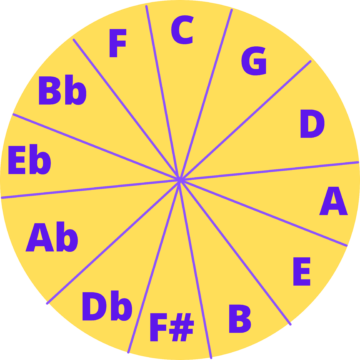Jazz Piano – A Complete Guide for Beginners

You’ve started learning the piano and you want to add a little spice to your piano playing? These tips will help you learn the basics of playing jazz piano music.
At some point on your musical path, you’ll ask yourself if it’s time to learn jazz.
And the truth is, the sooner, the better.
Maybe now’s the time?
Jazz piano music is famous for its sophistication. It incorporates highly complex music theory, which musicians work hard to understand and apply.
The smooth vibes that flow from keys and brass like smoke and wind are the fruit of all that thinking and learning.
Whether you end up playing for a living or not at all, learning jazz opens the mind and heart. It teaches you to listen more deeply and step out of your comfort zone.
This article builds on what you already know about scales, chords, and notes. By the end, you’ll be familiar with everything you need to begin learning jazz piano.
A brief history of jazz.
Jazz music originates in New Orleans, USA, in the early 1920s. Once the music of enslaved Africans, jazz became the sound of the mid-20th century, with its heart and soul in Harlem, New York City. It was revolutionary in its breaking of rules, evolutionary in its sophistication, and inspiring in its sense of freedom.

Jazz music is a language of improvisation. Once you learn the ins and outs, the idea is to pick a standard jazz tune and SPEAK!
The circle of fourths/fifths.
Remember learning about intervals?
An interval is a space between two notes. This space creates the relationship between the notes, and that’s what harmony is all about. You can check our article on ear training to jog your memory.
Before we explain the circle of fourths/fifths, you should feel it for yourself.
And by the way – get ready to have your mind blown.
First, get your butt to a piano and play middle C.
Then, play a series of perfect fifth intervals going up the piano (C, G, D, A, etc.)
You’ll see that eventually, you get back to C! Also, you’ll hear that these notes are in harmony with each other.
Now, play the highest C on the piano.
Then, play a series of perfect fourth intervals all the way down until you hit C again (C, F, Bb, Eb, etc.). You’ll notice that you’re playing the same series in the opposite order!

This series is the circle of fourths/fifths because it’s a never-ending cycle, with intervals of perfect fourths moving in one direction and perfect fifths in the other. It looks like this:
So, why is this relevant?
Most jazz songs are built from different chord progressions which move around the circle of fourths/fifths. The most common is the 2-5-1 progression.
The 2-5-1 progression.
The numbers 2-5-1 refer to the notes of a scale. You probably remember that we number the notes on any scale from one to seven. Each scale has its interval pattern that gives it its unique flavor.
Now take a look at the circle of fourths/fifths. You’ll notice that if you go backward from D, you get the progression D, G, C.
If you go back to your C major scale, you’ll see that these are the second, fifth, and first degrees. And it works like this with any and every note! Move anticlockwise around the circle and you’ll be playing a never-ending series of 2-5-1 progressions. This precious piece of music theory appears in every jazz tune ever written.
What type of chords do I play in a 2-5-1 progression?
Because jazz musicians like to break conventions, there are several different answers. Usually, the two is a minor 7 chord (1 b3 5 b7), the five is a dominant 7 chord (1 3 5 b7), and the one is major 7 (1 3 5 7). In C major, it looks like this:

Jazz music is all about learning to improvise over progressions like the 2-5-1. You just need to understand the different variations of scales at your disposal. This is how you will create interesting and catchy jazz hooks on this progression.
Before you know it, glorious madness will pour out of your piano.
The blues scale.
This is where jazz began. This six-note scale is a variation of the minor pentatonic (five-note) scale. The only difference is one more crunchy note called the blue note.
Back in the day, jazz and blues musicians would just improvise melodies with this scale for hours on end while receiving heckles from the crowd.
This is the numerical formula for a blues scale: 1 b3 4 #4 5 b7 1
In C major, for example, it looks like this: C Eb F F# G Bb C
Can you guess which one’s the blue note?

Practice playing this scale slowly, in the key of C.
When you’re comfortable, try improvising a melody using only these notes.
When that’s too easy, try it in all twelve keys!
Swinging eighth notes.
Despite their fancy harmony and complex melodies, jazz musicians are all about groove and feel. There is nothing like a swinging jazz tune to make every cell in your body move. You may know how it feels, but what is swing?

Remember learning about quarter notes? If not, check out this article.
In essence, swing is about playing eighth notes (half quarter notes).
What swings about them is that they’re uneven. This makes the music feel loose and fluid, in contrast to the stiff sound of straight eighths.
Try this exercise to get a sense of it:
Flick on your metronome. Make the time signature 4/4, and the tempo 60 beats per minute.
First, just clap along with the metronome. These are the quarter notes.
Now, play two even claps per click of the metronome. These are the straight eighth notes.
When that feels easy, see if you can make every second clap a little shorter than the one before it. It can feel a little uneven at first.
A good way to think about it is that straight eighths are like someone walking down the street. Swung eighths are like somebody limping down the street – but loving life as they do!
For a more in-depth explanation and demonstration of swing, check out our Simply Piano app, or do some more reading here.
Learn a jazz standard for beginners.
Are you ready to apply all of this to a legit jazz standard? We’ve chosen one that’s easy but fun and absolutely swingin’.

C Jam Blues – Duke Ellington
This tune has only two notes and four chords. Its simplicity is what makes it so fun to play. By learning it, you put all of the knowledge in this article to the test.
The notes of the melody are C and G.
You need to know the chords C7, F7, Dm7, and G7.
You’ll notice that these are the first, fourth, second, and fifth notes of the C major scale (with some cheeky variations within the chords because jazz musicians just can’t resist!)
And most importantly, all the melody notes are eighth notes, and they all swing.
Check out this chart for more details and this recording of the famous ‘Oscar Peterson version’ of the tune. Don’t worry – the recording is 10% melody and 90% improvisation!
Did we scratch your jazz itch?
It’s important to remember that jazz is not for everyone. Many music education institutions force their students to learn jazz, even when it’s not what they’re into.
There is value in all musical learning, but the most important thing is letting your love and curiosity guide you.
So if you’ve finished reading this article and decide that jazz piano doesn’t make you want to groove, it doesn’t make your heart sink, and it doesn’t tickle your imagination – just let it go for now and save it for a rainy day.









